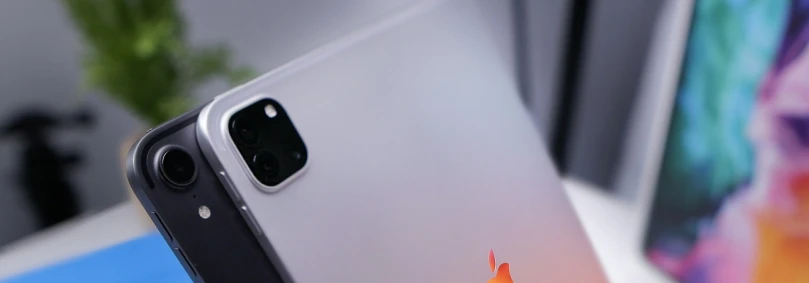2025 marks 15 years since the first-ever iPad hit the shelves. What originally caused some division among critics and consumers on launch has proven to be an enduringly popular product: iPad sales have routinely reached $20-30 billion every year since.
Last year, Apple sold more than twice as many iPads as MacBooks. This longevity is in part due to Apple’s continued iteration of the line and regular hardware releases. Expanding the iPad brand from a single model to a fully-fledged product line, incorporating eSIM connectivity and Pencil Pro support, and adding an ever-expanding array of accessories, has helped to establish modern iPads as a fundamental sector of the mobile device market, and in many cases, a viable alternative to laptops or desktop computers.
Looking ahead, we explore the full history of Apple’s tablet line, from the first prototypes to the 2025 iPad Pro.
The 1990s: Apple's early tablets
The iPad is so ubiquitous that it now serves as the archetypal image of a tablet computer, particularly among younger generations. It’s important to note that tablets were on the market long before the first iPad made its debut in 2010. This wasn’t even Apple’s first attempt: the Californians had previously experimented with portable computing in the 1990s with the MessagePad, a line of handheld “personal digital assistants” that featured a stylus input, large LCD screens, and AA battery power.
After 5 years of middling sales and inconsistent performance, Apple quietly discontinued the MessagePad line. The desire for a handheld personal computer remained a priority for CEO Steve Jobs, however. Jobs and iPhone designer Jonny Ive continued development on the idea, eventually relaunching the concept under the name “iPad” and releasing their first model in January 2010.
2010: The first iPad
As with many Jobs-led Apple product launches of the 2000s, the first iPad premiere received significant fanfare, including a mixed initial public response. The sleek design of the 9.7-inch, 1.5lb frame was praised, though there were some industry reservations about the name, the target audience, and the product's USP. Nevertheless, the first iPad sold 300,000 units within 24 hours. Initially launched as a Wi-Fi-only device, Apple later released a model that also featured 3G mobile connectivity (achieved via physical SIM card).
2011-12: the mini and the iPad 2

With the iPad 2 outselling its predecessor, Apple significantly invested in its tablet line in 2011, resulting in a second iPad model: the mini.
Launched in 2012, the mini was the first truly one-handed iPad, offering the same functionality as the regular version in a narrower 8-inch package. This year also saw the release of the 3rd and 4th generation iPads. The first new models after Jobs’ death in March 2011 continued his legacy of powerful performance and minimalist design by packing in a sharper display, faster processors, better cameras, and improved LTE connectivity (on selected models).
2013: the iPad Air
While the 3rd and 4th generation of iPads offered subtle improvements on the iPad line, 2013 saw a major update to the series: the introduction of a third model in the iPad lineup, the Air. At just 7.5mm deep, the iPad Air was dramatically thinner and lighter than the core line and able to perform the same functions. The popularity of the mini in previous years also saw Apple release the mini 2 in 2013, with an improved screen resolution, battery life, and processor.
2014: small refinements
The success of the iPad Air led to the 2014 release of the Air 2, an even thinner, faster version. The mini 3 also appeared, with some functional improvements to screen resolution, processing speed, and software functionality. This year also marked the debut of Touch ID across nearly all Apple devices
2015: the Pro debut

Where 2014 was a year of subtle iterations to the iPad line, 2015 saw a major change with the release of the fourth model in the iPad family: the iPad Pro. With a 13-inch screen, the Pro was the largest and most powerful iPad so far. Unlike other iPads, it supported the Apple Pencil stylus and Magic Keyboard, positioning it as a professional tool for designers and office workers. This was the first time an iPad was directly marketed as an alternative to a laptop or desktop computer.
2015: the iPad returns
After 5 years without a new regular iPad model, Apple rebooted its core tablet line with the 5th-gen iPad. Where its predecessors have been subsumed by the Pro, Air, and mini, the 5th-gen iPad was reimagined as a durable, (relatively) inexpensive, and user-friendly model for families, schools, and commercial use.
2018: the first iPad eSIM
By 2016, the Apple Pencil (previously only available with the iPad Pro) was supported by the new 6th-gen iPad. The Pro, meanwhile, was completely redesigned – the home button was removed and the framed 13-inch screen replaced by a single edge-to-edge display.
The most significant development was under the glass, however. The 3rd-gen iPad Pro was the first iPad model with built-in eSIM connectivity. Where previous iPads had been able to access wireless mobile data via a physical SIM card, this iPad Pro could simply download an eSIM from an official Apple partner like BetterRoaming and get online anywhere, just like the iPhone. This transformed the capabilities of the device. Today, eSIM connectivity is an optional feature in every iPad model.
2019: iPadOS
2019 saw the launch of iPadOS, a dedicated tablet operating system designed for the iPad’s dimensions. This replaced the iPad’s reliance on iOS and underlined Apple’s commitment to the ongoing development of its tablet line. The faster, sleeker 5th-generation iPad mini also debuted, while the new iPad was rebranded as a stepping stone between the entry-level regular iPad and the flagship Pro line.
2021: improved performances across the line

The 9th-generation iPad launched, with a suite of features that made it viable for professional use (though still not as powerful as the Air or Pro). The surging demand for videoconferencing tools in the midst of the COVID-19 lockdowns prompted Apple to introduce “Center Stage” mode for the iPad, a feature that automatically tracks and maintains camera focus on any person in the camera’s field of view. The rear-facing camera, too, was shifted to the longer edge of the iPad to better facilitate landscape video recording for videoconferencing and FaceTime calls.
The iPad Pro (5th generation) continued its trajectory as a serious contender to desktop computers with a new M1 chip, the fastest ever in an iPad.
2024: Ongoing improvements
The next years saw incremental improvements to performance, screen resolutions, and features across the iPad line. The latest iPad Pro runs on an M4 chip, delivering desktop-grade speeds, and features optional storage capacities of up to 2TB.
The Air and the mini provide similar levels of performance in differing packages, while the iPad, now in its 11th iteration, still delivers performance worthy of a professional device. All iPad models currently on the market are available as Wi-Fi + Cellular models, able to use built-in eSIM connectivity to download an official iPad SIM profile and get online, anywhere.
2025 and beyond
Fifteen years after its launch, the iPad has evolved from a less-powerful iPhone variant to a full suite of tablet computers, each with a range of functions, features, and cellular connectivity. With enduring sales numbers and a rumoured redevelopment in 2026, Apple looks set to continue to invest in and improve the range in the future.
A prepaid iPad cellular package, like the ones from BetterRoaming, is a hassle-free, easy-to-manage way to get online with an iPad. iPad eSIM data plans can now be installed in seconds, directly from the settings app. Visit our iPad eSIM page to try 100MB for free.
Can I use different network providers with my iPad and iPhone?
Yes – even if you use the same Apple ID across multiple devices, you’re free to use different network providers in each one. For example, having a multi-month phone contract in your iPhone and a prepaid eSIM in your iPad or Apple Watch. The same eSIM technology also makes it easy to switch between carriers on the same device. A common case is temporarily switching from a home network provider to a prepaid travel eSIM when going abroad.










